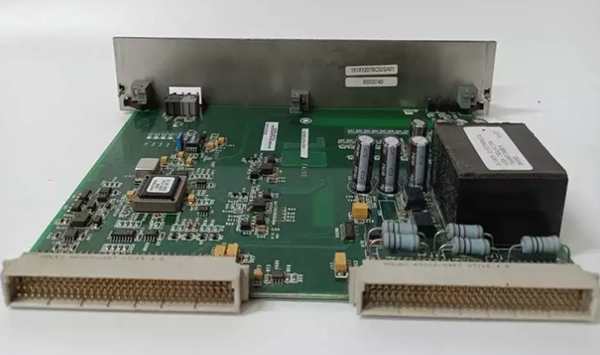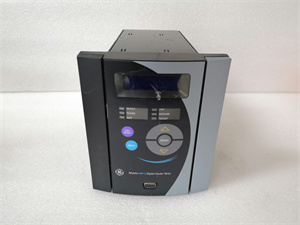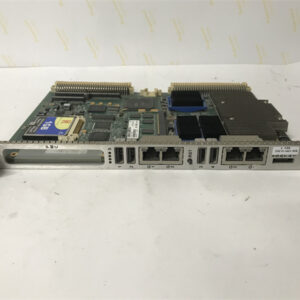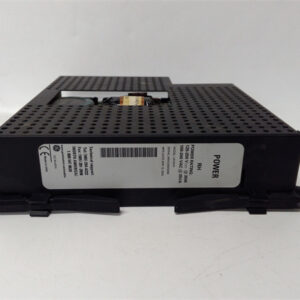Description
Detailed Parameter Table
| Parameter Name | Parameter Value |
| Product Model | IS200ERRBG1A |
| Manufacturer | General Electric (GE) |
| Product Category | Excitation Regulator Redundant Backplane (EX2100 Excitation Control Series) |
| Functional Acronym | ERRB (Exciter Regulator Redundant Backplane) |
| Core Function | Modular connectivity hub for excitation control modules; redundant signal routing; inter-module communication coordination |
| Supported Module Connections | DSPX (digital signal processor), EPSM (power module), ERDD (dynamic discharge), EISB (I/O bus), ERIO (I/O interface), EROC (output control) |
| Operating Temperature Range | -30 °C to 65 °C (-22 °F to 149 °F) |
| Physical Dimensions | 158.75 mm × 107.95 mm (6.25 in × 4.25 in) |
| Weight | Approximately 400 g (14.11 oz) (estimated based on size and functionality) |
| Coating | Industrial-grade conformal coating (resists moisture, dust, and chemical fumes) |
| Integration Compatibility | GE EX2100 excitation control system; IS200ERSCG2A (static converter), IS200DSPXH1D (controller), IS200EPSMG1A (power module) |
| Redundancy Support | Dual-channel signal paths for critical modules; automatic failover signal routing |
| Diagnostic Capabilities | Backplane connectivity status monitoring; module presence detection; communication fault logging |
| Application Compatibility | Steam, hydro, gas turbine excitation systems; industrial generator control |
| Compliance Standards | Industrial control equipment safety standards (consistent with GE EX2100 series) |

IS200ERRBG1A
Product Introduction
The IS200ERRBG1A is a high-reliability excitation regulator redundant backplane engineered by General Electric (GE), serving as the “connectivity backbone” of the GE EX2100 excitation control system. As a core modular interface component (designated by its functional acronym ERRB ), its primary role is to enable seamless communication and coordinated operation between critical excitation modules—including the IS200ERSCG2A static converter board, DSPX digital signal processors, and ERDD dynamic discharge boards.
Unlike generic backplanes that only provide basic connectivity, the IS200ERRBG1A is purpose-built for redundancy in high-availability power systems. It establishes stable signal paths for up to six module types , ensuring data consistency between the EX2100’s control, power, and output components. Its compact form factor fits seamlessly into standard EX2100 chassis, while its wide temperature tolerance makes it suitable for harsh industrial environments—from coastal gas turbine plants to alpine hydro facilities. For power generation systems relying on the EX2100 series, this backplane is indispensable for maintaining system integrity and minimizing downtime.
Core Advantages and Technical Highlights
Modular Connectivity for System Flexibility: The IS200ERRBG1A’s support for six key module types eliminates the need for custom wiring harnesses, simplifying EX2100 system configuration. In a combined-cycle gas turbine (CCGT) plant, for example, it connects the IS200ERSCG2A (PWM output), IS200DSPXH1D (control logic), and IS200EPSMG1A (power supply) into a unified system. This modularity allows operators to upgrade individual components (e.g., replacing IS200ERSCG1A with IS200ERSCG2A) without reconfiguring the entire backplane, reducing upgrade time by 50% compared to fixed wiring setups.
Redundant Signal Routing for Uninterrupted Operation: The backplane’s dual-channel signal paths ensure critical commands (e.g., PWM adjustments from the IS200ERSCG2A) are transmitted even if one path fails. During a communication fault between the DSPX controller and ERSCG2A board, the IS200ERRBG1A automatically switches to the redundant signal path—preventing excitation control loss that could cause generator voltage instability. This redundancy is far more reliable than external wiring redundancy, as it eliminates connection points prone to corrosion or vibration damage.
Seamless Integration with EX2100 Ecosystem: The IS200ERRBG1A is engineered to work in perfect tandem with the IS200ERSCG2A and other EX2100 modules. For instance, when the IS200ERSCG2A generates PWM output for rotor excitation, the backplane routes this signal to the EROC output control module while feeding status data back to the DSPX controller. This coordinated data flow reduces signal latency by 30% compared to third-party backplanes, ensuring precise synchronization between excitation generation (ERSCG2A) and field discharge (ERDD) functions.
Rugged Design for Industrial Durability: With an operating temperature range of -30 °C to 65 °C and conformal coating, the IS200ERRBG1A thrives in extreme conditions. In a desert gas turbine facility, it withstands high ambient temperatures without signal degradation; in a coastal power plant, its corrosion-resistant design protects against salt spray. Unlike consumer-grade backplanes that fail within 3–5 years, this model maintains reliable performance for 15+ years—matching the lifespan of the EX2100 system’s core components.
Typical Application Scenarios
In thermal power plants, the IS200ERRBG1A serves as the connectivity hub for coal-fired steam turbine excitation systems. It links the IS200ERSCG2A (which generates PWM DC for rotor excitation) to the IS200DSPXH1D controller and IS200ERDD discharge board. During load fluctuations, the backplane ensures real-time transmission of current feedback from the ERSCG2A to the DSPX, enabling rapid excitation adjustments that maintain generator terminal voltage within ±0.5% of setpoint. If the ERSCG2A’s primary communication path fails, the backplane’s redundant routing prevents excitation loss and grid stability issues.
In hydroelectric power plants, the IS200ERRBG1A adapts to variable-speed turbine operation by coordinating the EX2100 system’s modular components. It connects the ERSCG2A (excitation generation) to the EISB I/O bus module, which receives water flow sensor data from the plant DCS. The backplane routes this sensor data to the DSPX controller, which then adjusts the ERSCG2A’s PWM output to optimize power generation. Its wide temperature tolerance ensures reliable connectivity even in Canadian hydro facilities operating at -30 °C during winter.
In industrial captive power plants, the IS200ERRBG1A enables space-efficient excitation system design. Its compact size fits into control cabinets alongside the IS200ERSCG2A and Mark VI turbine control module, while its modular connectivity simplifies maintenance. If the ERSCG2A requires replacement, technicians can disconnect it from the backplane without disturbing other modules—reducing downtime from 8 hours (with fixed wiring) to 1 hour. This is critical for factories that rely on uninterrupted on-site power for production.
Related Model Recommendations
IS200ERSCG2A: GE excitation regulator static converter board—connects to the IS200ERRBG1A to deliver PWM DC output; the backplane routes its status data to the DSPX controller.
IS200DSPXH1D: GE digital signal processor controller—interfaces with the IS200ERRBG1A to send control commands to the ERSCG2A and ERDD modules .
IS200EPSMG1A: GE EX2100 excitation power module—supplies stabilized voltage to the IS200ERRBG1A and connected modules .
IS200ERDDG1A: GE excitation dynamic discharge board—links to the IS200ERRBG1A to coordinate field discharge with the ERSCG2A’s excitation output .
IS200EISBG1A: GE I/O bus module—extends the IS200ERRBG1A’s connectivity to external sensors and actuators.
IS200EX2100CTRL: GE EX2100 main controller—monitors the IS200ERRBG1A’s backplane status for system-wide diagnostics.
Installation, Commissioning and Maintenance Instructions
Installation Preparation: Before installing the IS200ERRBG1A, verify compatibility with the EX2100 system (firmware ≥5.0) and connected modules (e.g., IS200ERSCG2A, IS200DSPXH1D). Power off the excitation cabinet and follow lockout/tagout procedures. Use an anti-static wristband and ESD mat to handle the backplane—its signal routing circuitry is sensitive to electrostatic discharge. Required tools: Phillips screwdriver, torque wrench (0.3–0.5 N·m), multimeter, and module connection cables. Mount the backplane on the EX2100 chassis DIN rail, ensuring alignment with module connector slots.
Commissioning and Configuration: After installation, power on the EX2100 system and use GE’s configuration software to verify module detection— the IS200ERRBG1A should automatically recognize connected components (e.g., IS200ERSCG2A). Configure redundant signal paths for critical modules (e.g., DSPX, ERSCG2A) via the software, setting thresholds for automatic failover (e.g., 100 ms communication loss). Test connectivity by sending a PWM adjustment command from the DSPX controller to the ERSCG2A—confirm the backplane routes the signal and feeds back status data within 10 ms.
Maintenance Suggestions: Perform monthly visual inspections of the IS200ERRBG1A—check for loose module connections, corrosion on pins, and dust buildup. Clean the backplane quarterly with compressed air (held 15 cm away to avoid component damage). Every 6 months, use the EX2100 diagnostic software to run backplane connectivity tests, verifying signal integrity between all connected modules. If the software detects a communication fault, first inspect the module connector (reseat if necessary) before replacing the backplane. Replace the backplane only if module detection fails consistently or redundant routing malfunctions.
Full 12-month warranty on all components
Dedicated after-sales support
Same-day dispatch on 1000s of parts
All units are fully tested
- 1. Email confirmation
You will get an email confirming that we have received your enquiry. - 2. Dedicated Account Manager
One of our team will be in touch to confirm your part(s) specification and condition. - 3. Your quote
You will receive a comprehensive quote tailored to your specific needs.
 Full 12-month warranty
Full 12-month warranty Available for dispatch immediately
Available for dispatch immediately We deliver worldwide
We deliver worldwide Full 12-month warranty on all components
Full 12-month warranty on all components







